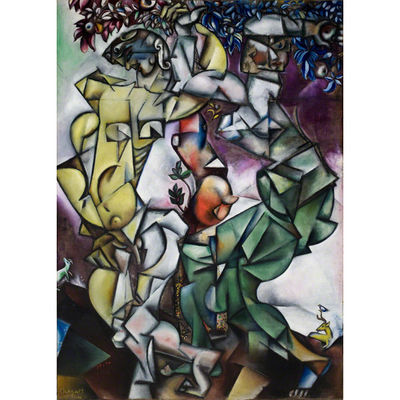Geometric Shapes in Artwork
Math Topic: Basic Geometric Shapes
Grade Levels: Grades K - 5
By: Ann Rule, Ph.D. and Anneke Bart, Ph.D. Saint Louis University
Lesson plan design adapted from: Wigging, G. & McTighe, J. 1998. Understanding by Design. Alexandria,
VA: ASCD.
Missouri GLEs
| Grade | GLE | Description |
|---|---|---|
| K | MA 2 1.0 | identify and describe 2- and 3-dimensional shapes using physical models. |
| 1 | MA 2 1.6 | use models to compose and decompose 2-dimensional shapes. |
| 3 | MA 2 1.6 | predict the results of putting together or taking apart 2- and 3-dimensional shapes. describe the results of subdividing, combining and transforming shapes. |
| 4 | MA 2 1.0 | name and identify properties of 2- and 3-dimensional shapes and describe the attributes of 2- and 3-dimensional shapes using appropriate geometric vocabulary |
| 5 | MA 2 1.10 | compare and analyze 2-dimensional shapes by describing their attributes. |
Mathematical Context:
- Problem Solving
- Reasoning
- Communication
- Making Connections
- Designing and Analyzing Representations
Identify Desired Results
Understandings:
- Students will understand the connection between geometric shapes and their uses in creating pieces of artwork
- Students will understand the visual effects of using geometric shapes in artwork.
- Students will understand how geometric shapes are used as design elements in art.
Essential Questions:
- Why is it important to explore geometric shapes in the real world?
- What are the relationships between geometric shapes in art and geometric shapes in math?
- How can learning about geometric shapes in different pieces of artwork develop a heightened sense of geometric shapes in mathematics?
Planned Learning Experiences
Objectives:
- Through exploration of geometric shapes in pieces of artwork, students will be able to identify basic geometric shapes.
- Through exploration of geometric shapes in pieces of artwork, students will be able to construct their own artwork based on geometric shapes.
- Through exploration of geometric shapes in artwork, students will be able to identify which shapes are best when drawing a head, arms, legs, etc.
Assessment Evidence
After exploring geometric shapes in chosen pieces of artwork in the art museum, students will complete the attached worksheet on Geometric Shapes in Art. Students are expected to accurately complete the worksheet with 90% accuracy.
Learning Activities
Motivator: A field trip to the St. Louis Art Museum to explore geometric shapes in art.
Procedures (what will students do?)
- Students will be directed to chosen pieces of artwork in the museum, where they are given background on the artwork e.g., Temptations by Marc Chagall, French, etc.
- Students will explore the geometric shapes in the artwork.
- On the handout (attached) students will be asked to fill in the appropriate information as they explore the artwork.
- Students will be asked to design their own piece of artwork based on the geometric shapes identified in the painting.
Closure: Ask students key questions about what they’ve learned about geometric shapes and how they relate to both mathematics and art.
Geometric shapes in Art Worksheet
Objective: Recognize basic geometric shapes and explore their use in modern art.

Question I:
- What geometric shapes do you see in this painting?
Question II:
- Use geometric shapes to draw your own picture of a man and a woman.
- What are the best shapes for a head?
- What are the best shapes for the arms and legs?
(Note that different answers are possible for Question II!)